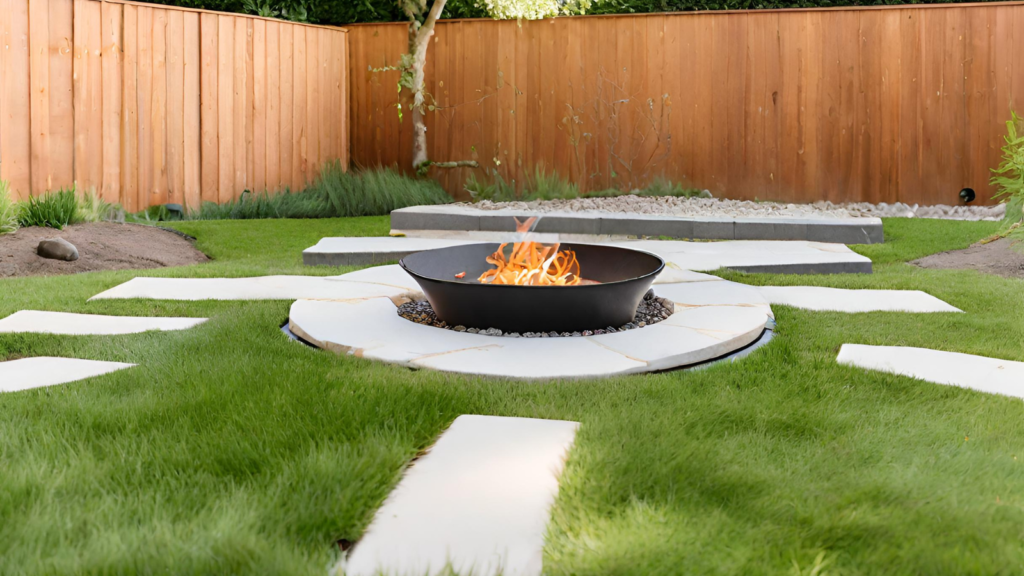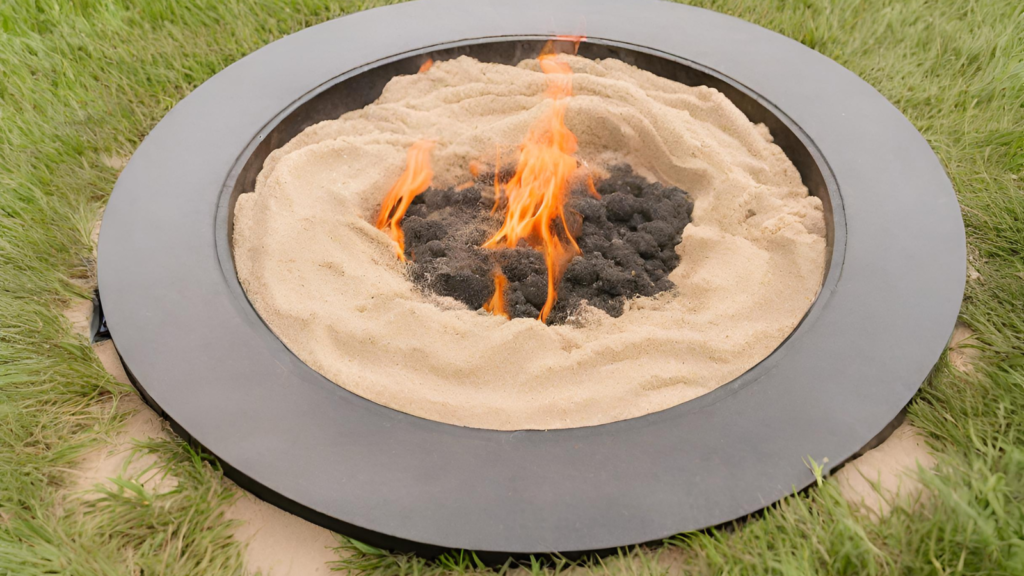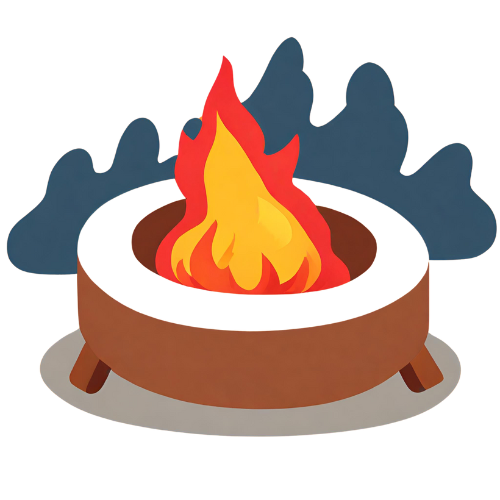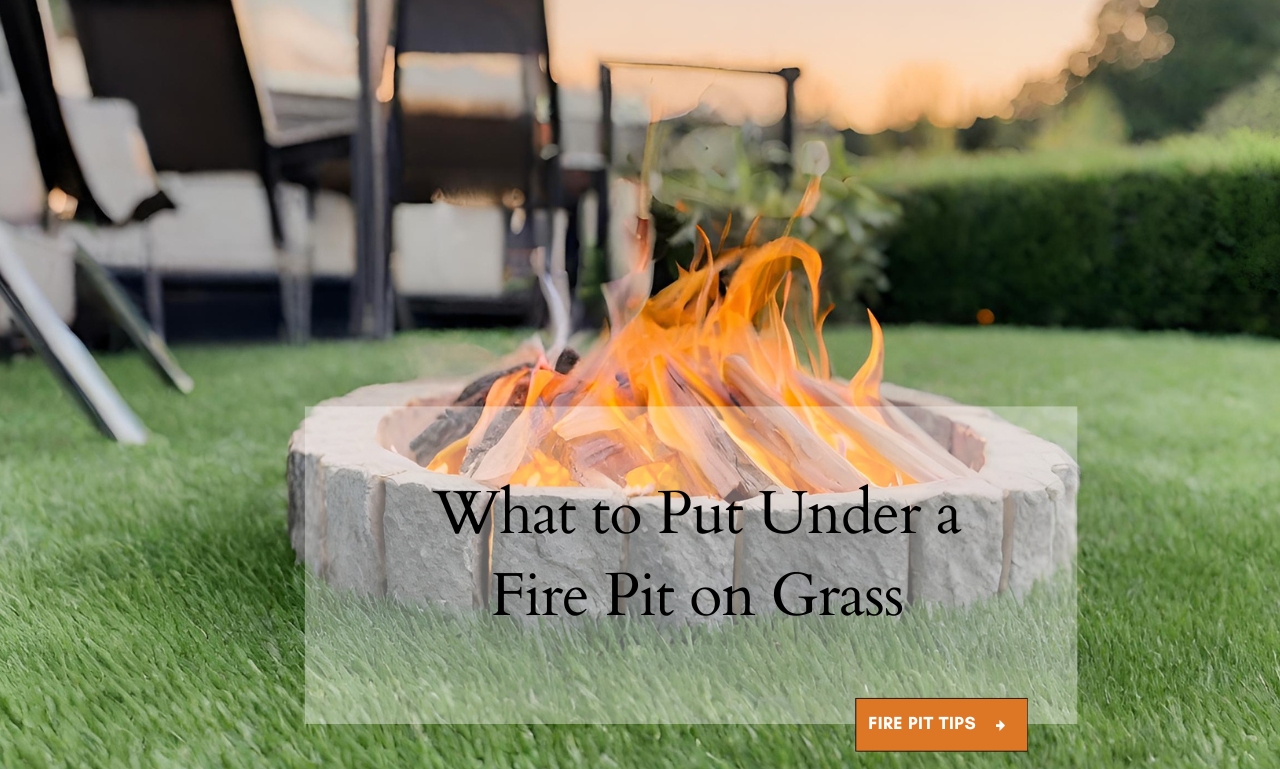Are you wondering what to put under a fire pit on grass? It’s important to protect your lawn from the heat of a fire pit. Placing a fire pit directly on grass can damage your lawn, leaving unsightly burnt patches. You need something under your fire pit to shield your grass from the heat.
A good base under your fire pit keeps your grass safe. This base can be something like a slab, mat, or even sand. It needs to be heat-resistant and stable. The right material will stop heat from reaching the grass. It also makes your fire pit safer to use.
I have tried using patio slabs, fire pit mats, sand, metal shields, and even soil or mulch under a fire pit on grass. All of them work well to protect the grass. In this blog, I’ll share the most interesting things about each option. You’ll find out how they can keep your lawn safe from the heat of the fire pit. Each one has its good points, and I’ll help you understand which one might be the best for you.
#1 Patio Slabs

Patio slabs are a great choice for under a fire pit. They provide a durable and heat-resistant base. This means your fire pit can get hot without damaging the grass underneath. Patio slabs are strong and can hold the weight of a fire pit easily.
These slabs shield the grass from direct heat. They act as a barrier, stopping the heat from reaching the grass. This helps prevent your lawn from getting scorched or burnt.
Patio slabs also ensure stability and safety. A fire pit needs a flat, stable base. Patio slabs provide this, keeping the fire pit steady. This is important to prevent accidents.
Using patio slabs under your fire pit also adds to the look of your outdoor area. They come in different styles and can make your fire pit area look more attractive.
Pros of Using Patio Slabs
- Durability: They last long and can take the heat without any damage.
- Heat Shield: They act like a shield, keeping the heat away from your grass.
- Safety and Stability: They keep your fire pit steady and safe, stopping it from tipping over.
- Aesthetic Appeal: They can make your fire pit area look nicer, as they come in various styles.
Cons of Using Patio Slabs
- Heavy: They can be heavy and hard to move around.
- Installation: Setting them up might need some work and tools.
#2 Fire Pit Mats

Fire pit mats are designed to protect grass from fire pits. They are made from heavy-duty materials like steel or aluminum. This makes them strong and able to handle high heat.
Also Read – The 5 Best Fire Pit Mats for Decks in 2023
These mats are placed under the fire pit. They catch any heat or sparks that might harm the grass. This keeps your lawn safe and looking good.
Some fire pit mats have a water-resistant coating. This adds extra protection. It keeps the mat from getting damaged by rain or moisture. This means the mat can stay outside with your fire pit.
Fire pit mats are also easy to use. You just place them under your fire pit. They are light and can be moved easily if you need to.
Pros of Using Fire Pit Mats
- Protection: They stop heat and sparks from reaching your grass.
- Water-Resistant: Some come with a coating that keeps them safe from rain.
- Ease of Use: They’re light and easy to move, so you can put them under your fire pit without hassle.
Cons of Using Fire Pit Mats
- Limited Size Options: They might not cover a large area.
- Wear and Tear: Over time, they might wear out, especially in harsh weather.
#3 Sand

Sand is a simple but effective choice for under a fire pit. It acts as an insulator, preventing direct heat transfer to the grass. This keeps the heat from the fire pit from reaching the lawn.
Sand disperses heat evenly. This reduces the chance of scorching. The heat spreads out over the sand instead of going straight down to the grass.
To use sand effectively, you need enough of it. Make sure the layer of sand under your fire pit is deep enough. This ensures the best protection for your grass.
Sand is also a cheap and easy option. You can buy it at most home improvement stores. It’s easy to spread under your fire pit.
Pros of Using Sand
- Even Heat Distribution: It spreads the heat evenly.
- Affordable: Sand is cheap and easy to get.
- Easy to Use: You can just spread it under your fire pit.
Cons of Using Sand
- Maintenance: You might need to replace or add more sand over time.
- Messy: It can get messy, especially when wet.
#4 Metal Shield
A metal shield is another good option for under a fire pit. It creates a barrier between the flames and the grass. This stops the heat from damaging your lawn.
Metal shields are ideal if you use your fire pit often. They are durable and can handle a lot of heat. This means they last a long time.
Options for metal shields include steel sheets or fire pit rings. These are designed to go under a fire pit. They catch heat and sparks, protecting your grass.
Using a metal shield also adds safety. It keeps the fire pit stable and catches any stray sparks.
Pros of Using Metal Shields
- Durable: They’re strong and last a long time.
- Heat Barrier: They’re good at stopping heat from reaching the grass.
- Frequent Use: Ideal if you use your fire pit often.
Cons of Using Metal Shields
- Cost: They can be more expensive than other options.
- Heavy and Bulky: Moving them around can be tough.
#5 Soil or Mulch
Soil or mulch can offer some protection for your grass. This is a good choice if you don’t use your fire pit often. It’s better than putting your fire pit directly on the grass.
You need to monitor a fire pit on soil or mulch closely. They can still get scorched if the fire pit gets too hot. Make sure to check the area around your fire pit after use.
Soil or mulch are easy to get and simple to use. You just need to spread them under your fire pit. This creates a layer between the fire and the grass.
Pros of Using Soil or Mulch
- Natural Material: Both are natural and blend easily with your garden or yard environment.
- Accessibility: You can easily find soil or mulch, often already available in your yard.
- Some Heat Protection: They offer a basic level of protection, preventing direct contact with flames.
Cons of Using Soil or Mulch
- Limited Protection: They don’t offer as much protection as other materials, like patio slabs or metal shields.
- Risk of Scorching: There’s a higher risk of scorching or burning, especially with mulch, which can be flammable.
- Maintenance: You may need to replace or replenish them more frequently to ensure ongoing protection.

